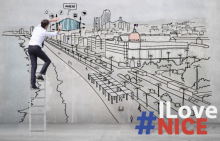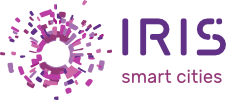
Interview with Paolo Moura, Head of Innovation & Strategic Partnerships at Université Côte d’Azur – IMREDD
“Every day is a day of progress” begins an upbeat Paolo Moura. “It’s up to us to decide how fast or slow that progress is…we can change things overnight if we are all engaged and decide to do it”.
We are at IRIS Smart Cities partner IMREDD, a pioneering research centre in the south of France focused on meeting the challenges of cities today – and tomorrow – and training a new generation of engineer and city leader to connect and manage challenges to: the environment, physical risks, energy and mobility.
At the heart of the centre is a technical platform designed to show just what’s possible for a sustainable and interconnected city when all the relevant stakeholders collaborate, share ideas and innovate freely. An impressive number of screens are full of data visualisations giving real-time analysis of a range of city services, infrastructure and feedback.
“As urbanization increases, the challenges become bigger and we have to address those problems – technology is key” says Moura. “Sometimes people are hesitant about how dominant technology can be; but essentially, it is not about the tech; it’s about a process, it’s about improving our understanding and enabling people to do things differently”.
In a string of examples, Mr. Moura speaks about the ‘humble bicycle’ and micro mobility modes such as scooters. These are not new or high-tech he argues. But what is, is the ability to integrate them into a connected transportation system, give real time information about location, availability, and make them a viable choice for moving around the city. Fixed and free-floating bike-share schemes across Europe are thriving, reducing emissions, encouraging modal-shift and redistributing space and infrastructure. Technology might even be able to wean us off our addiction to car ownership he thinks. “Do we need our own car? What type of car? When?… If we can keep 99% of the convenience, isn’t it more intelligent to be able to share the costs and significantly reduce our environmental footprint and space dedicated to vehicles in the city?”.
“The definition of mobility is the capacity to move from A to B. We lost that ability. Today we get stuck in traffic jams” he says gesturing out to the road. “We lose around 20 hours a month to them, but we don’t change our behavior because we are comfortable. Car-users don’t necessarily trust alternative options and find their cocoon, their refuge, in a car by themselves”. Cities have to find new ways to make existing and new options viable and attractive to make people rediscover the ability to move, especially at peak hours. “Infrastructure can and should be more flexible” argues Moura. “We rarely need six lanes for cars, so let’s transform them into more cycling lanes at weekends, or increased public transport speed and capacity when needed”.
“Energy is the same thing” he continues. “We use energy when at home, during peak hours. Unfortunately, that is the same time as everyone else… But commercial buildings use energy differently and at different times than residential buildings, so let’s increase the ability for energy to flow where and when it’s needed”. Finite resources like energy and water are precious and need to be optimized, not wasted or leaking from the system at current levels. “Let’s not take them for granted and improve awareness of where they come from or how we use them” urges Moura.
Stood before a wall of monitoring screens, essentially destined for professionals’ behind-the-scenes delivery, Moura also states the case for making more of this information available to everyone. Technology can also help us reach out and engage with consumers and citizens – making these issues a shared concern. “Illustrating and sharing data simply and effectively can get people to be concerned about the environment. We can help them see how it affects their quality of life and improve for the better when we adapt and change. Even if this seems insignificant, like leaving a laptop to charge when its already at 100%”.
This basis for visual facts and dialogue is even more essential when we consider the ‘cultural’ and ‘behavioural’ choices citizens make are significant source of emissions and we are instinctively resistant to change. Leaving a car at home, keeping a window shut, choosing to invest in energy-efficient renovations are tangible and significant assets in attempts to achieve emissions reductions and climate neutrality – but these levers belong to individuals and their homes. “Who knows the difference between 10 kilowatts or 100 kilowatts and what that means for the system and environment, really? Let’s put it into elements people understand, Euro’s in their pocket, time to spend with friends and family and so on”.
Speaking with Moura it seems that the role of technology to connect and engage government, private companies and citizens to address our sustainability challenges is key. Collectively, we must all also be prepared to challenge our assumptions and question or behavior and choices in the face of the data highlighted – from policy and financing down to behavioural and consumer. Perhaps it’s time to take data and tech off a pedestal and see it as a facilitator for the human, immediate and useful choices that can connect us to a smarter way of living in cities.

20 Feb 2020

